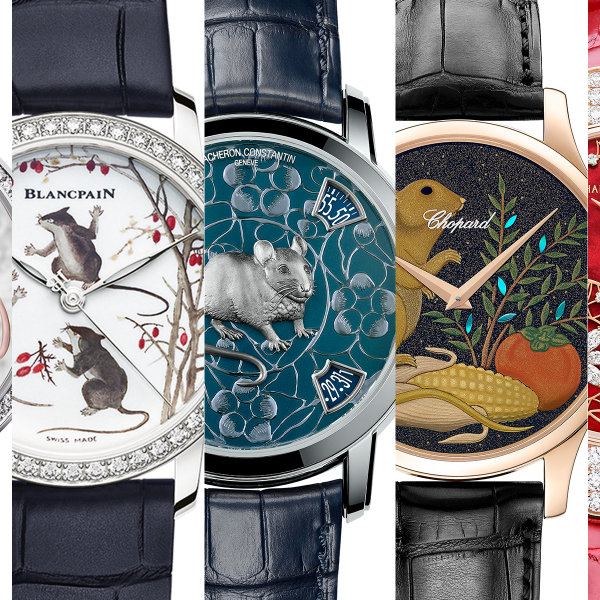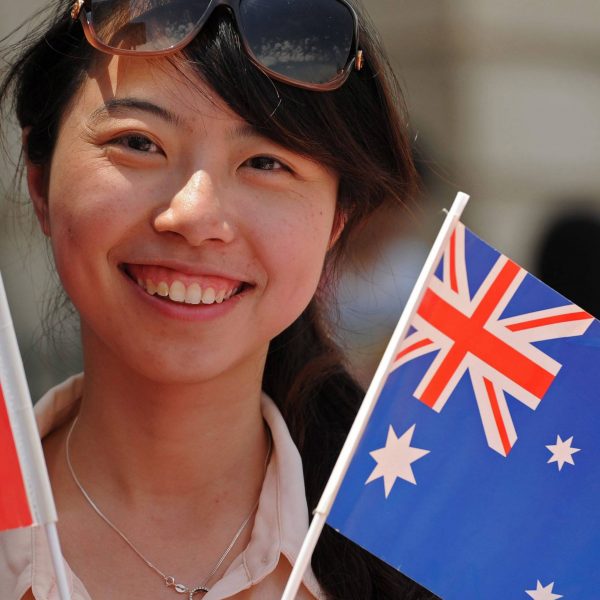
Christmas is Gaining Steam
Christmas is gaining steam in China, mostly through the influence of television and movies. but also as a highly anticipated occasion among Chinese consumers to fill the period between the illustrious shopping frenzy of Singles’ Day and the inevitable red lanterns of the coming Lunar New Year. Brands and distributors are committing serious marketing dollars to Christmas promotions — and with good reason: It’s a huge opportunity for high street retailers to take advantage of the generosity of people around this time of year
Though the popularity isn’t close to that of Western countries, it would still be foolish not to jump aboard in 2019. Here’s everything you need to know about the upcoming Christmas in China, along with how brands have taken advantage of this festive period in the past, and what your brand can do this year.
Overview of Christmas in China
Celebrating Christmas in China
Christmas in China is not widely celebrated as a religious holiday (less than 5% of the population are Christian), but the commercial aspects are still alive — particularly in more cosmopolitan areas.
While Christmas is still a working day in China, many larger cities have embraced the festive occasion. Central boulevards and malls have been illuminated with decorations that play well to local consumers’ love of twinkly lights and neon. On weekends, European-style Christmas markets fill public spaces in China’s larger cities, with expats being outnumbered by a greater portion of mulled-wine sipping locals each year.
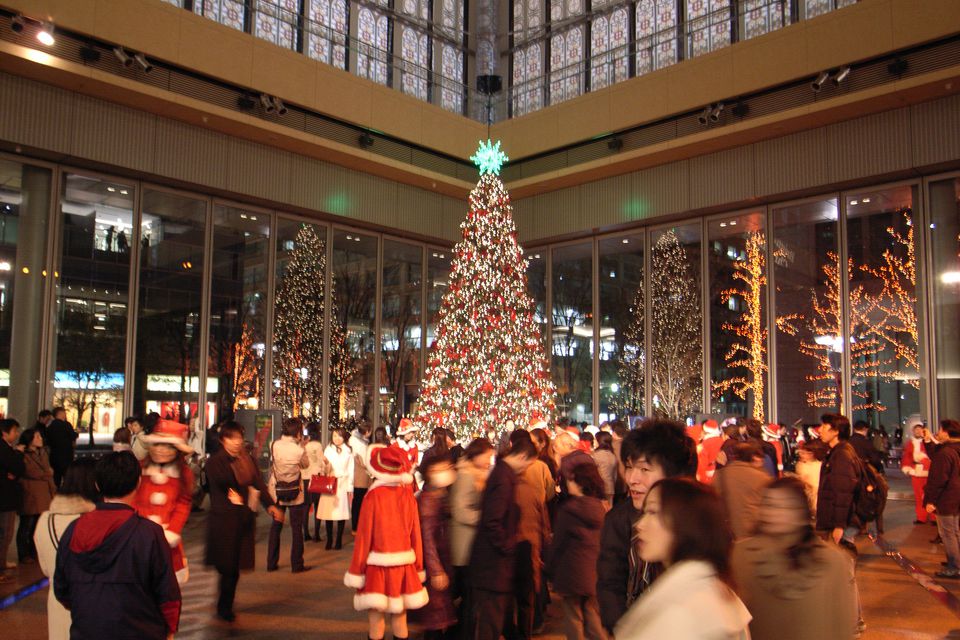
Impressive and picturesque displays of lights can be seen outside pretty much every large shopping mall in China’s major cities, sometimes up to a month before Christmas Day itself.
When Chinese people see these Christmas trees, sparkling lights and shining bows, they seem to wonder “What’s this, what’s this?!”. Unable to resist the lure of the atmosphere, they are magnetically attracted to it — providing many brands an opportunity to position themselves as international, modern, and fun, all of which appeal to China’s much sought-after millennial.
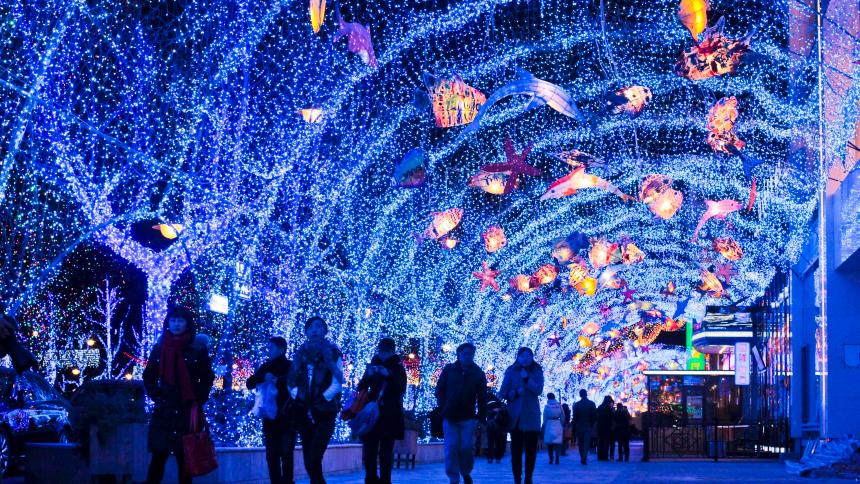
Christmas traditions for Chinese consumers
China becomes more global, it has started to welcome a commercialised version of Christmas, known as “Sheng Dan Jieh”. Like everything else, Chinese people have their own unique takes on this festive period, with traditions that differ from those in the West.
Romantic Holiday
During Christmas, Chinese young people celebrate with friends and significant others, contrary to the family-oriented culture in the West. They might choose to go out to a movie, karaoke, or go shopping. Young couples make it a day for dating and celebrate by exchanging small gifts.
Preparation for Chinese New Year
While some families don’t celebrate Christmas, they do use it as a way to prepare for the Spring Festival. They might pay respects to their ancestors by putting up portraits. They might also put out fruits that symbolise peace and wealth like apples and oranges.
Giving of gifts
Gift baskets filled with food and other items are common, and are often given to the host or hostess during a holiday visit. Rather than gifts some might also give a hongbao (red envelope) with lucky money, much like at the Spring Festival.
Paper Ornaments and Tree of Lights
One of the most popular Chinese Christmas traditions is to hang beautiful paper lanterns indoors, outdoors, and strung around the plastic Christmas tree. Families add paper chains and flowers in bright, festive colours to the Christmas tree. These paper lanterns are said to reduce stress, promote positive energy, bring good fortune and can signify a happy marriage.
Chinese Christmas Food
Rather than turkey and stuffing, a Chinese Christmas menu would look similar to a Spring Festival fair with roast pork, stuff duck, jiaozi (Chinese dumplings), spring rolls, and rice. A fun and unique tradition in China is the giving of apples on Christmas. Much like Valentine’s hearts, these apples are beautifully boxed and typically contain unique and fun sayings. They are also known as peace apples, and are given to loved ones.
Chinese Marketing for Christmas
The main demographics that are celebrating
According to demographic data sourced by Linkfluence, Christmas is a holiday that is celebrated more by younger people. This makes sense, as gift giving is prevalent and young couples are likely offering gifts to one another.
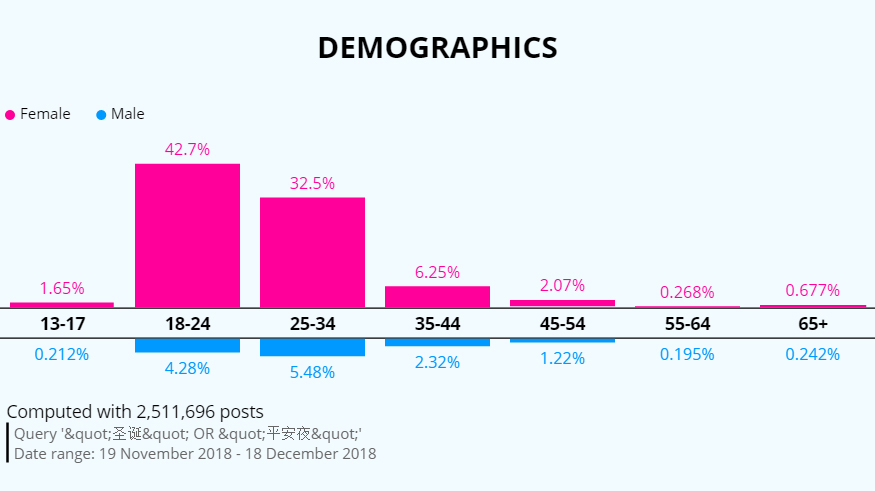
From this we can gather that the people who are most interested in shopping during Christmas are young females in their twenties to early thirties. We know from past case studies that Chinese female shoppers have a preference for products that are natural and organic.
Christmas KOL campaigns for Christmas
Like any other huge holiday, Christmas will have brands competing against one another for the hearts of Chinese consumers. Below we take a look at some of the most engaging Christmas campaigns from the past to give you a sense of what a winning recipe for engagement and brand awareness looks like.
and delve into a winning recipe for engagement and brand awareness.
Swarovski x Becky Li
Swarovski enlisted the help of Becky Li to promote their limited edition Advent Calendar Boxes, which each contained 24 gifts, including 3 full priced items and 21 surprise gifts. They were quick to sell out, thanks to the combination of engaging interactive WeChat Mini-Games and Becky Li’s masterful storytelling of Christmas history, traditions and decoration tips. Swarovski also promoted the QR code of the WeChat campaign in their physical stores, which allowed them to drive both in-store purchases and awareness of their WeChat platform.
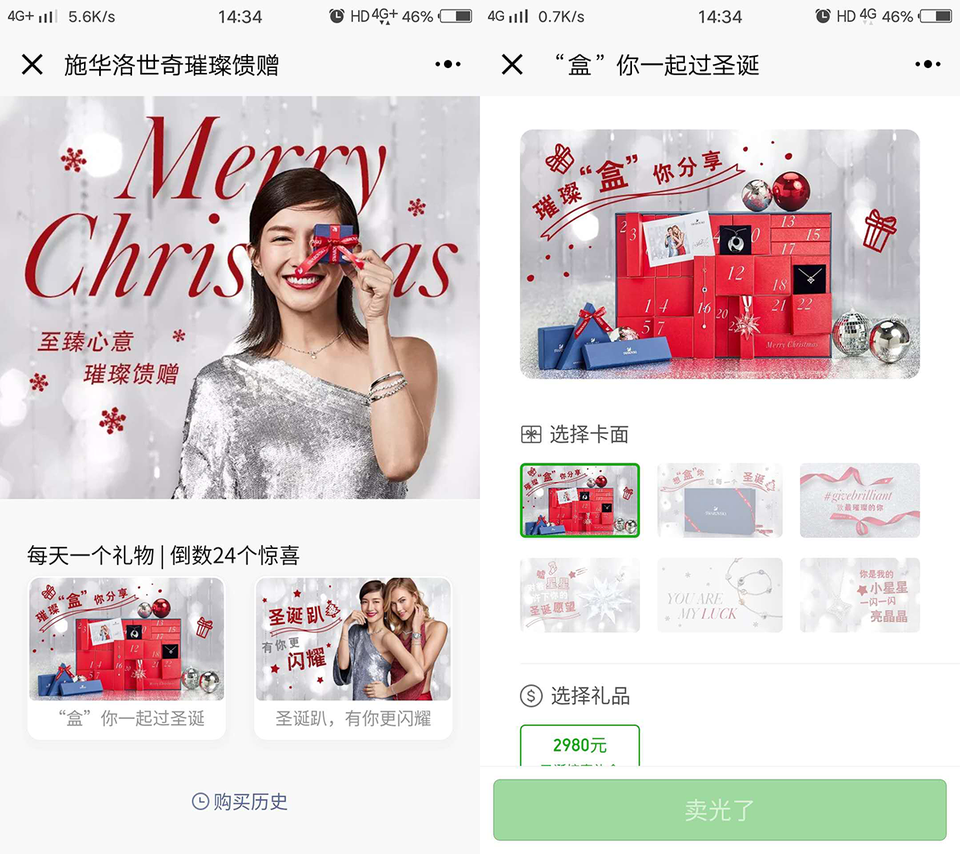
Luxury Brands x Mimeng
KOL Mimeng followed a similar theme with her 1.4 million WeChat fans posting 11 Christmas gift ideas for girlfriends, promoting foreign brands such as Tiffany, Michael Kors, Fuji Film, Hermes, Kate Spade, Phillips and Givenchy. The most comments received luxury lipsticks and some garnered as many as 10,000 likes.

L’OCCITANE x Brother Cream and Celine Yeung
L’OCCITANE launched a virtual Christmas treasure hunt for its fans. To create word-of-mouth and subvert expectations, L’OCCITANE partnered with two popular KOLs that weren’t beauty-related — Brother Cream ( a cat) and Celine Yeung (a young girl), both of which launched several posts on their WeChat pages to provide fans hints on where to find the treasures.
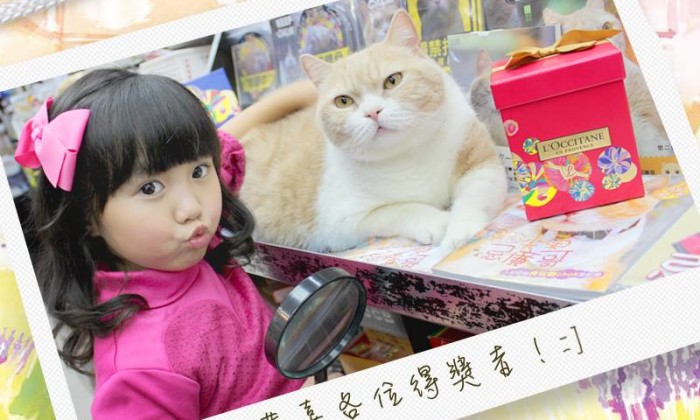
The campaign was a huge success and attracted more than 200,000 views, 3,000 shares and more than 10,000 participants. Apart from the game, there were two more features to help drive conversions: bounce back coupons that were distributed to all users, as well as the direct links provided to the online store so users could make purchases easily – a strategy to drive actual visits to the brick-and mortar stores.
Preparing for Christmas in China – Six Tips for Brands in 2019
1. Focus on China’s larger cities
In 2018, Christmas in at least four cities in China were banned, as the government aimed to enforce “traditional Chinese values and cultures” in light of a growing tide of cultural nationalism stoked by the country’s trade war with the United States. However, larger more prosperous cities across China were unaffected. Tier one cities like Beijing and Shanghai were sprawling with banners, lights, decorations and Christmas sales.
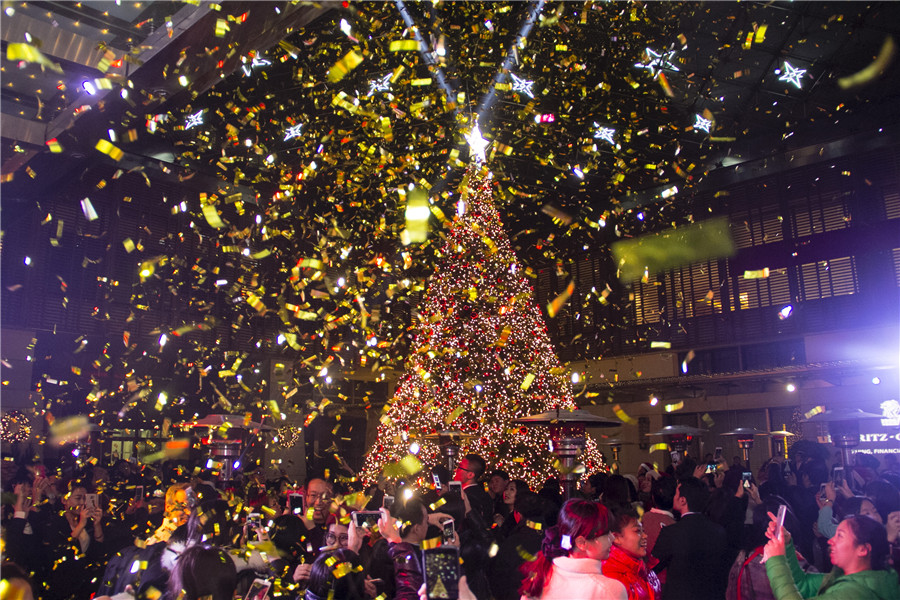
The takeaway here is that it is likely more countries will become exempt from the Christmas cheer in 2019, which is why your brand should direct your marketing strategies towards China’s tier one and tier two cities.
2. Use multiple digital marketing channels
As we can see from the KOL examples, social media is essential in supporting a brand’s Christmas campaign. This doesn’t have to be just WeChat, it can be Weibo, XiaoHongShou, Douyin and Youku, or any of the other dozen digital marketing platforms in China. Let’s take a look at the Chinese brand DJI, a Shenzhen company that sells over two-thirds of the world’s drones. They use a multi-channel strategy to promote their product line with special Christmas discounts and festive illustrations which will be familiar to Western customers at home.

Brands can replicate this by choosing the right KOL, then preparing plenty of engaging, exciting and value-adding content across multiple Chinese social media platforms. Remember that your content strategy should allow the re-purposing of content across different digital channels, leveraging the unique advantages of each platform:
- WeChat for its interactive social element in Mini-Games,
- Weibo to promote news and updates,
- Douyin and XiaoHongShou for viral KOL video promotions.
You must also plan in a marketing resource to monitor the accounts for engagement and to manage viral campaigns such as seasonal competitions.
3. Targeted online advertising in China
The right targeted online advertising campaign can place your brand and your Christmas China marketing campaign on the right websites, using engaging rich media adverts that are designed to meet the values, needs and interests of your target market. This process can be made easier through a powerful advertising management platform which optimises your demographic targeting, ad placement and campaign management, with the provision of in-depth analytics in real-time. These types of platforms also uses cookie-based audience targeting which helps to drive conversions and grow brand awareness, ensuring that your budget is put to best use and without waste.
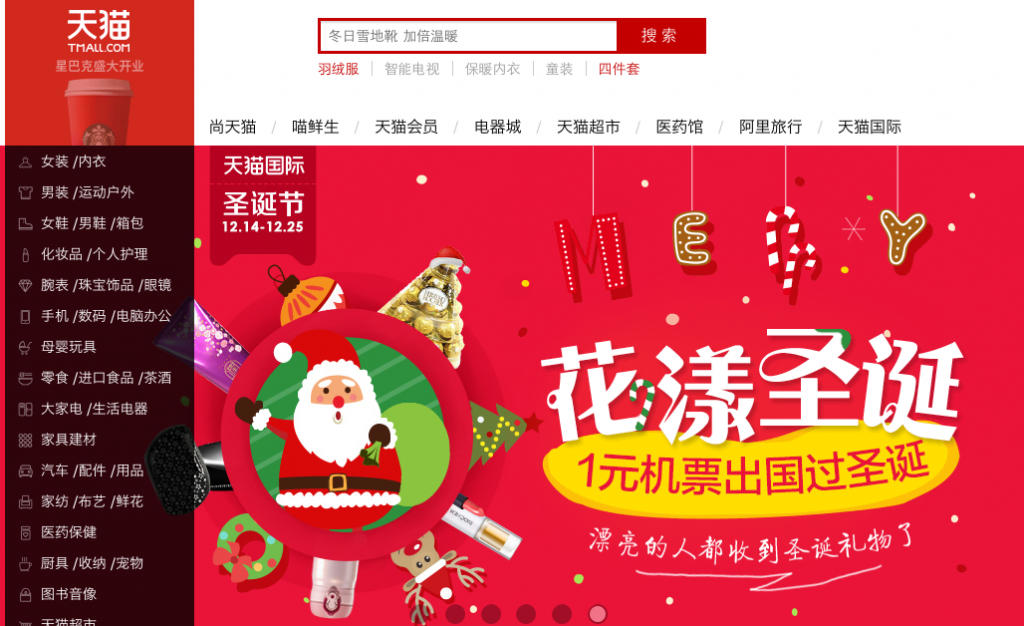
4. Personalise products and messages
It’s a season for sharing. Not only gifts, but content as well. Chinese shoppers want to share things that they think will add value to their network, and place greater sense of value on things that are personalised. The personal relevance appeals to their sense of self-identity and increases their emotional bond with the product. Enabling consumers to customise a message or product to send to their loved ones will increase their emotional response to the brand. The brand becomes personal and relevant to a customer.
Two great examples are Coke’s Share A Coke campaign and Oreo’s Design A Pack campaign in 2015. Both of these exemplify an appeal to personalisation and they give customers a reason to share the brand — which creates more loyal consumers, and word-of-mouth for campaign outreach.

5. Make Campaigns Finite
The worst part of any holiday season is that it eventually ends. So take advantage of this, and frame marketing campaigns, festive sales, and giveaway opportunities with an expiry date. This appeals to consumers through loss aversion, in which they will be more likely to engage with a campaign in fear of missing out (FOMO). Brands can accomplish this by having a kind of countdown, showing the number of days, minutes or even seconds before a campaign ends. This encourages a call to action.

Kogan, an Australian e-commerce platform, does exactly this. When there are consequences for not buying, it creates an urgency to buy. Limited edition offers that can be purchased directly on WeChat have an excellent track record in China (Just ask Givenchy or BMW) especially when the promotional content links the product with consumer characteristics and emotions.
6. Prepare for Chinese outbound tourism
Travelling during Christmas is developing into a new trend for younger Chinese tourists who have enough cash in their wallets as well as a great interest to experience Christmas in Western countries. The keyword for Chinese tourists going abroad during the festive season is undoubtedly shopping. Chinese tourists spend substantially more money on shopping while abroad than they, for example, spend on accommodation. As Christmas is traditionally a season of sales in the West, it is definitely regarded as an ideal opportunity for Chinese tourists to buy products of quality they can trust.
Basically, there will be a wave of Chinese tourists that will undoubtedly be arriving for the Christmas festivities and discounts. This means that even if your brand misses out the booming opportunity on the mainland, there’ll be plenty of Christmas pie to go around back in the West. Also to note, many people have started using their annual leave for Christmas, which they then combine with the New Year holiday — meaning that there will be consistent tourism throughout December to February.
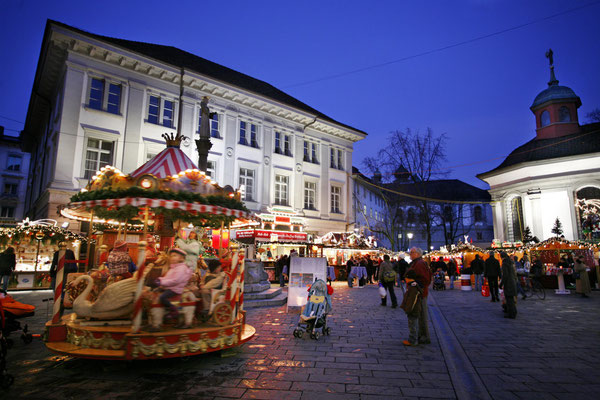
Get Started Now
Whether you’re a start-up looking to kickstart your Chinese social media, a mid-sized company looking for KOL partnerships, or a multinational looking for cultural insights and an extensive Chinese marketing campaign, Vantage Digital can help. We deliver value and measurable results through quality marketing strategies and strategic thinking.
What’s more, we’re so easy to partner with. In fact, collaboration is something we truly pride ourselves on. We can help any brand get started on their journey, and be with them every step of the way. So the question is, are you ready to take your Chinese marketing to the next level?

